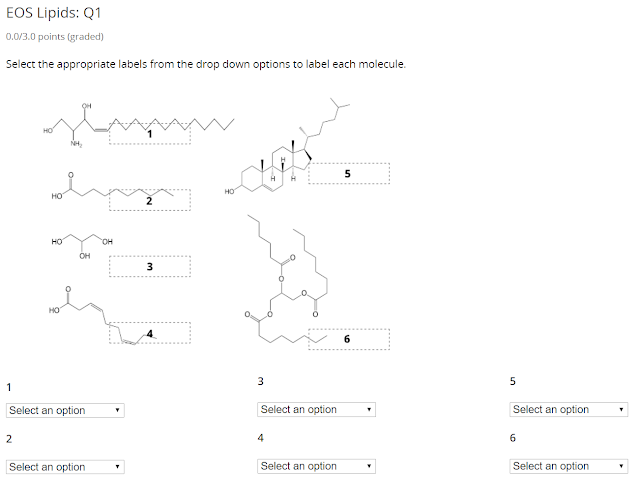Molecule 1 is sphingosine - notice the amine group. It is a backbone molecule just like glycerol is.
Molecule 2 is a saturated fatty acid - it has a carbonxyl group and a saturated tail.
Molecule 3 is glyercol
Molecule 4 is an unsaturated fatty acid
Molecule 5 is cholesterol, with these four rings.
Molecule 6 is triacylglycerol.
Triacylglceryol is efficient energy storage, so option 1 is wrong.
While the hydrophobic repulsion of Triacylglceryol is there, that does not explain its energy density, so option 2 is wrong, same thing with option 4.
The answer is option 3, the hydration of glycogen reduces its energy density relative to triacylglycerol.
The numbering is weird, it make much more sense to name the molecules inside out.
It starts with triacylglycerol (8).
When activated, ATGL (7) can start the first lipolysis process.
That generate diacylglycerol (5)
Which is then processed by the phosphorylated HSL (6) to continue the lipolysis.
Monoacylglycerol (4) is generated in the process.
It is then processed by MGL (3) to perform the last stage of lipolysis
The fatty acid (2) that is broken down in the triacylglycerol are carried by chaperone to the blood stream because they are hydrophobic, raw exposure of fatty acid in blood stream can be toxic.
Last but not least, the glycerol (1) is also transported through the blood stream, it doesn't need a chaperone.
The answer is 4 - hormone concentration in the blood communicate the energy needs of the body to adipocytes.
After fatty meal, the blood stream has more fat than usual, there is no reason for the body to mobilize stored fats, the opposite happens. Insulin is secreted and lipogenesis occur, fats get into adipocytes. So option 1 is wrong.
Hormone circulates in blood, they are usually hydrophilic (except from steroid hormone that needs a protein carrier), and they do not bind to fatty acid directly - put it the otherway, lipolysis haven't occurred yet, where are the fatty acid to bind to? They are deep inside the lipid droplet. So option 2 is wrong.
Option 3 is almost correct, during prolonged exercise, the body experience physiological stress, the hormone epinephrine (adrenaline) is secreted by the adrenal cortex under physiological stress. The beta adrenergic receptor on the adipocyte surface will be activated to trigger the lipolysis process. This is to mobilize the energy to handle the stress.
But notice it is the adipocyte surface, not the lipid droplet surface. So option 3 is wrong, we are almost there.
Option 4 is correct, hormone concentration in blood stream is the body's way to communicate the stress to adipocyte, so that it starts to mobilize the energy.
It is nice to correlate my knowledge in human physiology with my study in biochemistry.
Glycerol is not the chaperone, so option 1 is wrong.
Chaperone shuttle hydrophobic molecules through the aqueous cytosol and blood stream, not hydrophilic, so option 2 is wrong.
Glycerol and fatty acid are useful, they are not waste, so option 3 is wrong.
The correct answer is option 4 - they are exported to liver and muscle for energy usage. It is broken down to use the energy stored in the bonds.
The outer leaflet has more cylindrical shape lipid while the inner leaflet has more conical shape leaflet, so the answer is
Sphingomyelin is most likely enriched in the outer leaflet, while
Phosphatidylethanolamine is most likely enriched in the inner leaflet.
This arrangement look so nice, it is regular packing and in paracrystaline state. This is rigid.
Adding cholesterol to it will be make it more fluid because it will no longer be so nicely packed.
This is simple, just reading graph, it is lipid 1 and lipid 2.
Conical shape things are in inner leaflet, so it is lipid 3 and lipid 4 that is conical shape.
Lipid 1 need to move from inner to outer. Floppase is needed to move lipid from inner to outer, so the answer is floppase.
I have got this wrong - I was tricked by myself about permeability by being able to let's thing in. Of course, factor that block things out are just as important - arguably more important than letting things in.
The key factor of blocking things out is the hydrophobicity. Here is the correct option:
The hydrophobic core of the lipid layer.
The key factor of lettings things in is the integral proteins. Here is the correct option:
The integral membrane proteins that allow molecule to cross.
This is simple, just reading graph, 12% is too low, low body fat is lipodystrophy.
The fill in the blanks problem is completed in the image above.
The idea is simple - lipogenesis create fat, so the lipid droplet grow, and the opposite is lipolysis. When fed, insulin store energy. So there is only one option left for the last one.
An easy one - mutation 2 causes slower growth of weight with high fat diet, the only reason is that the rat body doesn't store the intake fat, that is lipodystrophy.














No comments:
Post a Comment